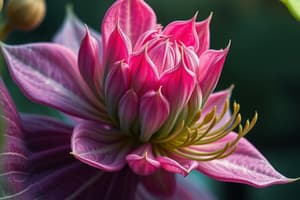Podcast
Questions and Answers
पौधों का अध्ययन क्या कहलाता है?
पौधों का अध्ययन क्या कहलाता है?
पौधों का अध्ययन बोटनी कहलाता है।
पौधों की बाहरी संरचना का अध्ययन किसे कहते हैं?
पौधों की बाहरी संरचना का अध्ययन किसे कहते हैं?
पौधों की बाहरी संरचना का अध्ययन पौधों की आकृति विज्ञान कहलाता है।
पौधों में जल और पोषक तत्वों का परिवहन करने वाले ऊतकों के प्रकार क्या हैं?
पौधों में जल और पोषक तत्वों का परिवहन करने वाले ऊतकों के प्रकार क्या हैं?
पौधों में जल और पोषक तत्वों का परिवहन करने वाले ऊतकों को विशालिका और फलिका कहा जाता है।
किस प्रक्रिया के द्वारा पौधे भोजन का निर्माण करते हैं?
किस प्रक्रिया के द्वारा पौधे भोजन का निर्माण करते हैं?
पौधों का पर्यावरण पर क्या प्रभाव पड़ता है?
पौधों का पर्यावरण पर क्या प्रभाव पड़ता है?
Flashcards
वनस्पति विज्ञान क्या है?
वनस्पति विज्ञान क्या है?
वनस्पति विज्ञान पौधों का वैज्ञानिक अध्ययन है, जिसमें उनकी संरचना, कार्य, वृद्धि, विकास, वितरण और वर्गीकरण शामिल हैं।
पौधे की आकृति विज्ञान क्या है?
पौधे की आकृति विज्ञान क्या है?
पौधे की आकृति विज्ञान पौधों के बाहरी आकार और संरचना का अध्ययन है।
पौधे की शारीरिकी क्या है?
पौधे की शारीरिकी क्या है?
पौधे की शारीरिकी पौधों में होने वाली रासायनिक और भौतिक प्रक्रियाओं का अध्ययन है।
पौधे की पारिस्थितिकी क्या है?
पौधे की पारिस्थितिकी क्या है?
Signup and view all the flashcards
पौधे के ऊतक क्या हैं?
पौधे के ऊतक क्या हैं?
Signup and view all the flashcards
Study Notes
Introduction to Botany
- Botany is the scientific study of plants, encompassing their structure, function, growth, evolution, distribution, and classification.
- It covers a vast range of topics, from the microscopic details of plant cells to the global patterns of plant communities.
- Key areas of botany include plant morphology, anatomy, physiology, ecology, and taxonomy.
- Plant diversity is remarkable, ranging from microscopic algae to towering trees, exhibiting a wide array of adaptations to various environments.
Plant Morphology
- Plant morphology refers to the study of the external form and structure of plants.
- This includes the study of leaves, stems, roots, flowers, and fruits.
- Leaf shapes, arrangements, and venation patterns can vary significantly across plant species.
- Stems support the plant, transport nutrients, and may be herbaceous or woody.
- Roots absorb water and nutrients from the soil.
- Flowers are the reproductive structures, featuring petals, stamens, and pistils.
Plant Anatomy
- Plant anatomy examines the internal structure of plants, including tissues and cell types.
- Primary tissues include dermal, vascular, and ground tissues, each with specialized functions.
- Dermal tissue covers the plant's surface, protecting it from pathogens and environmental extremes.
- Vascular tissue (xylem and phloem) transports water, minerals, and sugars throughout the plant.
- Ground tissue performs diverse functions including photosynthesis, storage, and support.
Plant Physiology
- Plant physiology investigates the chemical and physical processes occurring in plants.
- Essential processes include photosynthesis (capturing light energy to synthesize food), respiration (releasing energy from food), transpiration (water loss through stomata), and nutrient uptake.
- Plant hormones, like auxins, gibberellins, and cytokinins, regulate various aspects of plant growth and development.
- These hormones influence processes such as shoot elongation, root development, and fruit ripening.
Plant Ecology
- Plant ecology studies the interactions between plants and their environment.
- This includes the relationships between plants and other organisms (e.g., animals, microorganisms) and their physical environment (e.g., climate, soil).
- Plant communities exhibit unique adaptations to specific habitats.
- Factors such as sunlight, temperature, water availability, and nutrient content influence plant distribution and abundance.
Plant Taxonomy
- Plant taxonomy focuses on classifying and naming plants based on their evolutionary relationships.
- The hierarchical system uses ranks like kingdom, division, class, order, family, genus, and species to categorize plants.
- Phylogenetic relationships are determined based on shared characteristics and evolutionary history.
- Modern taxonomy relies on various data sources, including morphology, anatomy, physiology, and molecular evidence.
Plant Reproduction
- Plants reproduce both sexually and asexually.
- Sexual reproduction involves the fusion of gametes (sperm and egg) to produce offspring with genetic variation.
- Asexual reproduction, including methods like vegetative propagation, produces clones of the parent plant.
- Pollination, the transfer of pollen, is critical for sexual reproduction in many flowering plants.
Plant Diseases and Pests
- Plants are susceptible to various diseases and pests, which can significantly affect their health and productivity.
- Pathogens, including fungi, bacteria, and viruses, cause diseases.
- Pests, such as insects and mites, can damage plants through feeding or other activities.
- Integrated pest management strategies aim to minimize pest and disease impacts using environmentally friendly methods.
Economic Importance of Plants
- Plants play a vital role in human society, providing food, shelter, clothing, medicines, and many other resources.
- Crop plants are essential for agriculture, providing food for a large portion of the global population.
- Many medicines are derived from plants, with ongoing research focusing on the chemical compounds produced within plants.
- Plants are crucial for maintaining oxygen levels in the atmosphere.
Importance of Plants in Ecology
- Plants form the base of most food webs and are vital for maintaining the structure and function of ecosystems.
- They provide habitats for a wide range of animals and contribute to soil stabilization and nutrient cycling.
- Forests play a critical role in regulating climate and water cycles.
- Plant diversity is an indicator of ecosystem health.
Studying That Suits You
Use AI to generate personalized quizzes and flashcards to suit your learning preferences.
Description
यह.quiz वनस्पति विज्ञान के मूलभूत पहलुओं का अध्ययन करता है, जिसमें पौधों की संरचना, कार्य, विकास और वर्गीकरण शामिल हैं। इसमें पौधों की बाहरी आकृतियाँ और विवरण जैसे कि पत्तियाँ, तने, जड़ों, फूलों और फलों का विश्लेषण किया जाता है। यह विभिन्न पौधों की विविधता और उनके पर्यावरण के साथ अनुकूलन पर भी प्रकाश डालता है।



